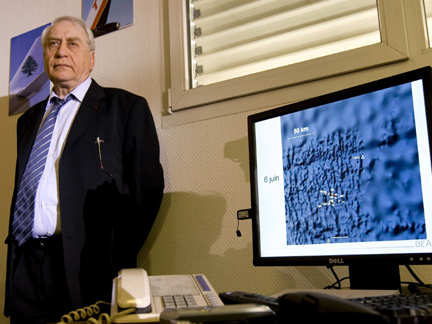Air France 447
Air France crash cause getting clearer, investigators say
Article published on the 2009-06-17 Latest update 2009-06-17 15:41 TU

Paul-Louis Arslanian, head of the Investigation and Analysis Bureau at the Paris Air Show, 17 June 2009
(Photo: Reuters)
At a press conference at the Paris Air Show, Paul-Louis Arslanian, director of the Investigation and Analysis Bureau (BEA), said, "considering all the work that has been done and all we have at our disposal, I think we may be getting a bit closer to our goal" of determining the cause.
Arslanian, however, did not give details about the work of the team of 60 investigators.
"For now, we cannot say, and no one can say what happened. It is much too soon to go imagining scenarios in one direction or another," he said.
Five days after the crash, the BEA did say that the plane's airspeed sensors, also called "pitot probes", had been feeding inconsistent readings to the cockpit. In the past, pilots of Airbus 330s, the same type of airliner as flight 447, have complained that these probes had failed.
Since that first announcement, however, the BEA, Airbus and Air France have all said that no link has been proven between the speed monitors and the crash -- although Air France upgraded all sensors on its long-haul fleet.
Asked whether it was an overreaction for airlines to change their speed probes, Arslanian said it was "a legitimate approach for companies who do not want to take any risks."
Meanwhile, an international search team is scouring an area of 19,000 square kilometres,with the focus on locating the "black box" flight data recorders.
A nuclear submarine and two other vessels equipped with listening devices have not yet detected the ping of the black boxes. The ocean in that area of the Atlantic is as deep as four kilometres.
Arslanian said investigators had so far recovered around 400 pieces of debris from the search area -- many of them small fragments of foam rubber or aircraft cabin furnishings.
He said, however, it was now "virtually certain that we will not recover the entire aircraft."
He also said he had yet to see the results of autopsies carried out by Brazilian authorities, adding that a French medical expert sent by the Bureau had not been allowed to take part in the post-mortems.
He denied during the briefing there were tensions with the Brazilian team over access to the autopsy results, but admitted to reporters afterwards that he was "not happy."
The plane went down 1 June En route from Rio de Janeiro to Charles de Gaulle airport outside Paris. All 228 people aboard died.













